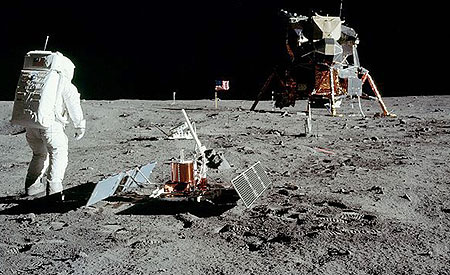Apollo 11 space craft landed the first humans on Earth’s Moon on July 20, 1969. The mission was carried out by the United States and was considered a major accomplishment in the history of exploration, and represented a victory by the U.S. in the Space Race Cold War with the Soviet Union.


Apollo 11 space craft landed the first humans on Earth’s Moon on July 20, 1969. The mission was carried out by the United States and was considered a major accomplishment in the history of exploration, and represented a victory by the U.S. in the Space Race Cold War with the Soviet Union.
Launched from Florida on July 16, the third lunar mission of NASA’s Apollo Program was led by Commander Neil Alden Armstrong, Command Module Pilot Michael Collins, and Lunar Module Pilot Edwin Eugene . On July 20, Armstrong and Aldrin landed in an area on the moon surface called the Sea of Tranquility, and became the first humans to walk on the Moon.
Their landing craft nicknamed Eagle, spent 21 hours and 31 minutes on the lunar surface while Collins orbited above in the command ship, The three astronauts returned to Earth with 21.55 kilograms of lunar rocks and landed back on earth in the Pacific Ocean on July 24.
Russian reaction to the landing by Americas on the moon
Soviet Union, had mastered manned space flight in a series of early orbital missions, it is said that the Moon quickly became a key goal of the manned space program.
In May 1961, President Kennedy proclaimed a manned landing on the surface of the Moon before 1970, as the main goal of the US space program.
However, it took more than three years after Kennedy’s challenge for the cash-strapped Soviet government to commit needed resources for the Moon Race.
It’s also said that one Russian leader by the names of Nikita Khrushchev reportedly told leaders of the Soviet rocket industry that "Anything you need in order to do it, will be provided but do not leave the Moon to the Americans.” On Aug. 3, 1964, the Soviet government finally gave full go ahead to the lunar landing effort.
However, the development of a heavy-lifting launcher, needed for the lunar expedition, was characterized by political and technical problems.
Mentioned also is that powerful captains of the Soviet rocket industry fought for the leadership and influence in the program which also stretched the project’s already limited resources, while the Soviet military, which financed rocket development, had always remained skeptical about the prospects of giant space launchers.
The fall of Khrushchev in 1964, further delayed the program, which continued suffering from the lack of funds and resources. In 1966, the Soviet lunar program received another blow with the death of its legendary leader, Sergei Korolev.
The N1 moon rocket had not reached the launch pad until 1969, and its first and three subsequent test missions ended in catastrophic failures, revealing serious technical problems in the design of the booster.
The program was finally abandoned in 1974 and its leader Vasily Mishin was ousted as a head of the industrial conglomerate responsible for the project.
Russia even got to the moon before when the unmanned Luna 2 crashed at the moon surface in 1959. But the drama of the first human footprint on an extraterrestrial body eclipsed everything the Soviets had worked so hard to achieve.
"Beginning with the first flight with a dog on the Russian spacecraft, and then getting to the moon, it was a great achievement for humanity,” Russian astronaut Sergei Krikalev said.
"Of course, we would have liked to see the first man on the moon be Soviet, Russian, but that’s life, our own achievements were very many.
"I think this is fine. It’s like sports - at one stage one person wins, at another it’s somebody else,” said Krikalev.
It’s said that the Soviet Union had two huge secret projects designed to win the moon race. The L1 project would send a Soviet crew around the moon before the Americans, using a stripped-down Soyuz spacecraft launched by a Proton rocket. The L3 project would beat the American Apollo program to the lunar surface. The Soviets lost both races.
In the case of being the first to send a man around the moon, that loss was measured in days or weeks. It’s also mentioned that after the loss, they perpetrated a hoax that they had never been in the race to begin with. The Soviet manned lunar programs however were only made public after the fall of the Soviet Union.
Ends


